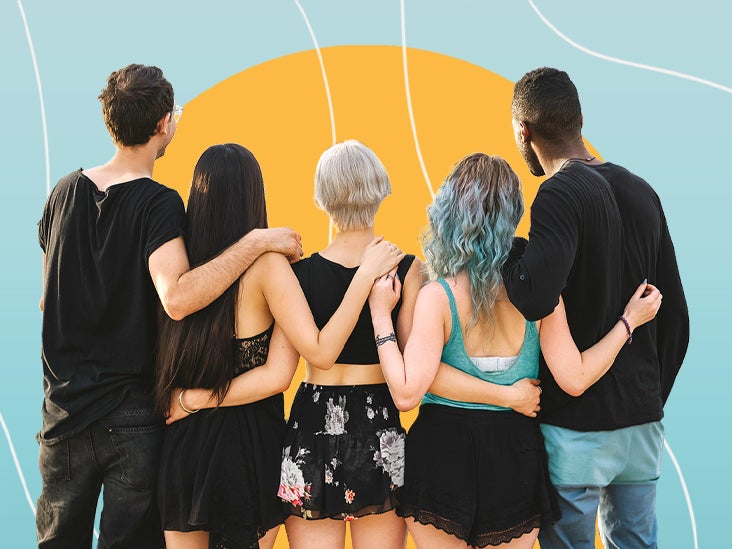
It’s a challenging time for LGBTQIA+ people in the United States.
Discriminatory legislation, like Florida’s Parental Rights in Education bill—dubbed the “Don’t Say Gay” bill—and Texas’ transphobic policy proposals that target gender affirming care, has created a damaging environment for the mental and physical health and well-being of LGBTQIA+ people at large, but especially for young people.
During this time of intense stress coming from a number of directions, LGBTQIA+ youth are finding that their very identities are being politicized.
This can trickle down to affect their health as would-be safe spaces, like schools, family households, and communities are now being infused with debates over LGBTQIA+ rights and visibility.
Healthline spoke with several experts about the challenges LGBTQIA+ youth are facing in the United States today and what actionable steps people can take to support them right now.
“LGBTQ young people often experience disproportionate mental health challenges because of how they are mistreated and stigmatized by society,” Jonah DeChants, PhD, research scientist for the nonprofit The Trevor Project, told Healthline.
When compared with their non-LGBTQ peers, LGBTQ young people are “significantly more likely” to experience rejection, discrimination, violence, bullying, and harassment, DeChants explained.
This can all “compound and produce negative mental health outcomes,” he added.
“It’s important to emphasize that LGBTQ youth face stressors that their peers simply never have to worry about, such as anxiety around coming out and fears of being rejected or discriminated against based on their LGBTQ identity,” DeChants explained.
“It’s also worth noting that recent polling data found that 85 percent of transgender and nonbinary youth — and two-thirds of all LGBTQ youth, or 66 percent — say recent debates about anti-transgender laws have negatively impacted their mental health,” he said.
Heather Zayde, LCSW, a Brooklyn-based clinical social worker and psychotherapist, said that right now in the United States, 238 anti-LGBTQ bills have been filed in 2022 alone.
These bills range from preventing transgender youth from participating in sports and banning discussion of LGBTQIA+ topics and issues in classrooms, to preventing gender affirming healthcare and even preventing young people from using bathrooms that correspond to their gender, she stressed.
“Individually, each of these bills creates its own level of harm, but together, LGBTQ youth are getting the message that they don’t have the right to exist and be happy,” Zayde told Healthline.
“So many youth use sports and sports teams as a community-building activity that helps them feel included. When trans youth are prevented from being on the teams that match their gender identity, they’re effectively banned from what could be an incredibly healthy coping mechanism to the stressors of daily life,” she said.
Zayde explained that these kinds of policies make these young people’s very bodies discussion points that are “called into question and labeled as wrong.”
Similarly, she singled out the “Don’t Say Gay” legislation that sends the message to youth that “their identities should be kept silent.”
Additionally, calling into question “the right to gender affirming healthcare and using the bathroom violate the most basic human needs,” Zayde added.
“These bills are incredibly dehumanizing,” she said. “Individually, they are horrible. The fact that so many have come up this year intensifies the message that LGBTQ youth are so wrong and bad that laws must be passed to silence and shame them.”
Both DeChants and Zayde outlined actionable steps people can take to support LGBTQIA+ young people right now:
Clearly stand as an ally to LGBTQIA+ youth
This might sound like an obvious suggestion, but health experts say it’s important to be very clear that you stand as an ally to the LGBTQIA+ young person in your life.
“This can include but isn’t limited to using a young person’s name and pronouns correctly, openly discussing LGBTQ issues, confronting anti-LGBTQ language or discrimination, and connecting youth with LGBTQ peers and mentors,” DeChants said.
Essentially, it should be clear to that young person that you are not ambivalent about supporting them and respecting them.
“Make the fact that you are a supporter or ally known,” Zayde said. “Some people wear a button or put up a flag to show this.”
Be politically engaged
Zayde said “we should all strive to speak out against [discriminatory] legislation far and wide … This will show LGBTQ+ youth that they are not alone, and that we as a society will not tolerate hatred, bigotry, and discrimination.”
DeChants said you can email officials in Texas, for instance, and “urge them to reject the governor’s unlawful campaign to prosecute parents who support their trans and nonbinary children using this action tool.”
Additionally, Zayde said to “vote wisely.” If you see that “a politician in any way supports anti-gay legislation, do not support them.”
“Check out the Equality Federation’s State Legislative Tracker to learn what, if any, anti-LGBTQ legislation is being pushed in your state,” DeChants added.
Respect and use gender pronouns
Using people’s pronouns is crucial for supporting their identity and not stigmatizing them. It all goes back to respect and empathy. It can go a long way.
This can also involve being visible about your own pronouns, even if you do not have an LGBTQIA+ identity yourself.
“Introducing yourself using your pronouns helps normalize it in everyday use and helps others to feel comfortable doing the same,” Zayde said.
Educate yourself about LGBTQIA+ issues
DeChants suggests you review The Trevor Project’s A Guide to Being an Ally to Transgender and Nonbinary Youth. This guide “covers a range of topics and best practices on how to support transgender and nonbinary young people,” he said.
Zayde echoes that, adding you can learn about LGBTQIA+ issues “through reading or attending events to show support.”
You can also “stay updated on the challenges of the LGBTQ+ community so that you can play an active role as a supporter,” she added.
DeChants also said it’s crucial you be aware of mental health threats that LGBTQ youth face.
“Take a moment to read [The Trevor Project’s] Facts About LGBTQ Youth Suicide to understand some of the key factors that put these youth at risk — as well as key factors that can help prevent suicide among this group,” he said.
Challenge anti-LGBTQIA+ rhetoric
This recommendation goes back to lessons you might have learned on the playground yourself as a child. If you see something — such as bullying — say something.
“If you hear anti-gay language being used, actively challenge it,” Zayde said.
This could be at your place of work, at a school, or on an online forum your child might be accessing. Part of being an ally is strongly affirming and defending youth who might be under attack.
Look up and direct others to resources
“Contact local LGBTQ groups in your community to see how they are supporting LGBTQ youth and if there are any ways in which you can help volunteer your time,” DeChants said.
He also added that if you are a “youth-serving professional,” try to “display The Trevor Project’s crisis contact information in a place that is easily accessible for the young people you serve.”
DeChants said that The Trevor Project’s trained crisis counselors are available 24 hours a day, 7 days a week via phone at 866-488-7386, via chat at TheTrevorProject.org/Get-Help, or by texting “START” to 678-678.
Try to make resources more accessible
Sometimes a school or community center might not have accessible information or resources for LGBTQIA+ youth.
Zayde said you can always request that LGBTQIA+ media or art is in your library, movie theater, museum, or school. If it’s not there or you can’t find it, encourage your community center to acquire it.
Remind them they’re not alone
If an LGBTQIA+ young person is upset about the news of the day, it can sometimes feel like there is no one around who can help them. This can contribute to stress and depression.
To counter this, DeChants said it requires an active approach to exercising empathy and support.
“Most importantly, remind the LGBTQ young people in your life that they are not alone, and that they are loved and supported exactly as they are,” he said.
In the face of current adversity, Zayde said now is the time for people from all walks of life to “fight against these bills on a larger scale.”
“Adults should do their best to push back against discriminatory legislation, whether it be speaking out on a micro-level in their family and community and/or actively reaching out to those responsible for such legislation.
“When LGBTQ+ youth hear us fighting back, it sends the message that they have a community of people on their side who support and love them, and will not tolerate the bigotry and hatred that these bills represent,” Zayde said.
She added one reason why she believes politically conservative people in the United States seem to support “Don’t Say Gay” bills popping up around the country is due to the fact that many of them might view “LGBTQ+ issues as only ones related to sex.”
“Our community is so much more than that. We are a culture of love, support, and care. Showing the strength and support our community represents can help highlight how complex and beautiful we are, and more than just with whom we choose to have romantic or sexual relationships,” Zayde said.
From his perspective, DeChants said all these stressors on LGBTQIA+ youth are a great burden right now.
Collectively, all LGBTQIA+ youth are dealing with a lot, but a lot of pressure is being put on transgender and nonbinary youth in particular.
DeChants cited The Trevor Project’s 2021 National Survey on LGBTQ Youth Mental Health that found “42 percent of LGBTQ youth seriously considered attempting suicide in the past year.” This includes “more than half of transgender and nonbinary youth.”
“And the political attacks aimed at trans and nonbinary youth in states across the country are only making matters worse. Every day, youth are forced to hear their very existence debated by the officials elected to represent them. For some, these harmful debates also happen among family members, classmates, and neighbors,” DeChants said.
Recent research has shown that, overall, the majority of U.S. adults would accept their children if they came out as lesbian, gay, or bisexual.
That said, the same research found that adults are somewhat less accepting of trans and nonbinary identities and are less familiar with issues and terminology associated with non-cisgender identities, like the use of people’s pronouns.
DeChants said acceptance and affirmation of LGBTQ youth can vastly improve mental health and reduce suicide attempts. He cited research that shows having at least one accepting adult “can reduce the risk of a suicide attempt among LGBTQ young people by 40 percent.”
Additionally, “a 2021 peer-reviewed study by The Trevor Project’s researchers found that transgender and nonbinary youth who reported gender identity acceptance from adults and peers had significantly lower odds of attempting suicide in the past year,” he said.
In a time when anti-LGBTQIA+ political rhetoric can collide directly with a young person’s mental health and well-being, now is not the time to be silent or offer passive support.
According to these experts, accepting and affirming a young person’s identity and also being there to offer the support and resources they need is key.
“Everyone, everywhere, can take simple but potentially lifesaving steps to support and affirm LGBTQ young people,” DeChants said.








